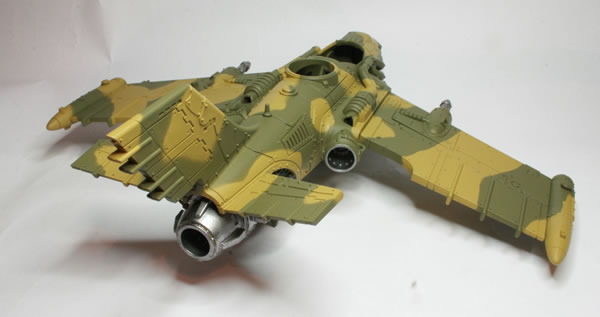I already have the resin model from Forge World, but this is the new(ish) plastic kit from Games Workshop.
As is the case with most of the new kits from Games Workshop, this model comes with a range of choices on how you fit the kit together. You can build a fighter version, a ground attack variant or a dive-bomber.
The most popular configurations of the Ork Bommer are the Dakkajet, the Burna-Bommer and the Blitza-Bommer.
I decided that I would build mine as per the Burna-Bommer, as I liked the rear turret, but would arm mine with the weaponry from the Blitza-Bommer and a couple of extra forward firing big shootaz!
Orks love fire and it was therefore inevitable that someday a Mek would think of attaching canisters of volatile promethium to the underside of an Ork Bommer – thus the Burna-Bommer was born. Armed with burna bombs and skorcha rokkits, the Burna-Bommer performs its attack runs at as low an altitude as possible. Such a technique is, as you can imagine, not without its hazards…
The model went together quite easily. The main issue I had was with the rear horizontal fins. The way they are connected means it is not a strong joint and initially the fin drooped. I therefore had to prop it up whilst the glue cured.
With the way I am going to paint the model I kept the cockpit, pilot and turret assembly separate, and the bombs as well.
I gave my constructed Ork Bommer a white undercoat. The next stage was a spray basecoat of German Armour Yellow. I used that colour, mainly as I had it in the house.
I decided after basecoating the Ork Bommer that I might do an experiment with this model and apply some camouflage. I decided to add a second spray, after masking off some of the basecoat, of a different contrasting colour. Looking through the cupboard I realised that I only had a dark green, whereas I did think a darker brown would have worked well. Ah well, I had time to paint, not much time though to go out and buy some new paint! In terms of masking I had three options, use some masking fluid, masking tape or blu-tac. I decided not to use the masking fluid, as I had not used it before, though I will probably have a go with it for the glass canopies. I did consider using masking tape, but I wanted curved lines not straight. So in the end went with the blu-tac. This I stuck on the model and then gave the model a spray of British Armour Green.
As this was an Ork scheme, I didn’t use any kind of regular pattern with the camouflage.
After letting the paint fully dry, I removed the blu-tac.
I was very pleased with the result.
It was then onto the detailing, painting the engines and guns, as well as the crew and cockpit. Here are two further components of my Ork Bommer, the cockpit and the rear turret assemblies. Initially they had a white sprayed undercoat.
The interiors were painted Chaos Black and drybrushed with Boltgun Metal. I then using Vallejo Middlestone for the exterior parts that will be showing. This (in theory) is the same colour as the original sprayed basecoat.
The next stage will be to add details to the main part of the bommer including the weapons and the engine. I used Citadel Boltgun Metal as the start for these areas.
Here is the bommer with the turret and cockpit in place.
This underside view shows the engine in more detail. The process is to first put down a base of Boltgun metal and then using shades and inks to add washes to bring out the detail.
The stage after painting the base coats and the details on the boomer I thought the next stage would be relatively much easier, however I was mistaken.
I was using a variety of Citadel shades initially, I left the boomer to dry. I found one of them I was using left a residue on the model. I was lucky that I was able to remove the residue with water and some kitchen towel. I am not sure what caused the problem, maybe one of age of my paints or not mixing it properly.
In the end I am quite pleased with the end result. What I was trying to achieve was a weathered aged look that is the result of a complete disregard to maintenance or care for the bommer. If this was a human Imperial Guard plane, it probably wouldn’t be able to fly, however as this is an Ork aircraft, it flies because of the sheer will of the pilot.
I have both volumes of the Forge World Masterclass books and they are a real inspiration and full of ideas and techniques for painting and weathering models.
I wanted to try and emulate some of those techniques on the engine of the Ork Bommer.
I have been using a combination of inks and shades on a base coat of Bolt Gun Metal. I then want to highlight parts of the engine, as well as adding some more grunge.
I intend to use some Forge World weathering powders and Citadel Technical paints to further enhance and weather the engines. I might though in the first instance try them on another model to ensure it works out how I want them to, but also what happens when I varnish the model.
I started painting the pilot.





























